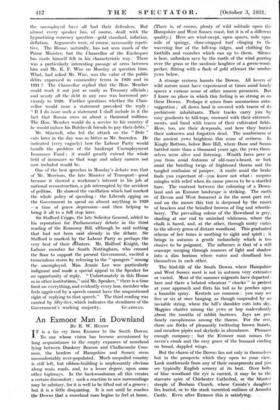An Exmoor Man in Downland
By E. W. HENDY IT is a far cry from Exmoor to the South Downs. -I- To one whose vision has become accustomed by long acquaintance to the empty expanses of moorland lying between Dunkery Beacon and Challacombe Com- mon, the borders of Hampshire and Sussex seem uncomfortably over-populated. Much unspoiled country is still left, but ribbon-building is unpleasantly obvious along main roads, and, to a lesser degree, upon some other highways. In the backwoodsman all this creates a certain discomfort : such a reaction to new surroundings may be salutary, for it is well to be lifted out of a groove ; but it is a little disquieting. It is not until he reaches the Downs that a moorland man begins to feel at home., (There is, of course, plenty of wild solitude upon the Hampshire and West Sussex coast, but it is of a different quality.) Here are wind-swept, open spaces, mile upon mile of springy, close-cropped turf clinging ;to the wavering line of the hill-top ridges, and clothing the foothills and coombcs which run up to them. Silence is here, unbroken save by the rustle of the wind purring over the grass or the sardonic laughter of a green-wood- pecker, flitting with a flash of gold athwart the sombre yews below.
A strange, eeriness haunts the Downs. All lovers of wild nature must have experienced at times amid lonely spaces a curious sense of other unseen presences. But I know no place in which this feeling is so strong as on these Downs. Perhaps it arises from unconscious auto- suggestion ; all down land is covered_ with traces of its prehistoric inhabitants. Their tracks carry you by easy gradients to hill-tops, • crowned with their entrench- ments, and lined with traces of their cultivated fields. Here, too, are their dewponds, and here they buried their unknown and forgotten dead. The sombrenesi of the ancient yews heightens this sense of eeriness. In Kingly Bottom, below Bow Hill, where Dane and Saxon battled more than a thousand years ago, the yews them- selves seem alive and listening. Wraith faces-peer at you from amid festoons of old-man's-beard, or lurk amid the bristling twigs of frightened thorns and the tangled confusion of juniper. A rustle amid the brake finds you expectant of—you know not what : surprise mingles with relief when its cause proves to be a startled hare. The contrast between the colouring of a Down- land and an Exmoor landscape is striking. The earth of Devon and West Somerset is for the most part red, and on the moors this, tint is deepened by the russet• of bracken and the brindled browns of ling and whortle- berry. The prevailing colour of the Downland is grey, shading at one end to smirched whiteness, where the chalk is bared, and, at the other, through- misty vistas to the silvery green of distant woodland. This graduated scheme of low tones is soothing to sight and spirit ; it brings in autumn a gentle melancholy which is too elusive to be poignant. The influence is that of a still seascape merging through nuances of light and shadow into a dim horizon where water and cloudland lose themselves in each other.
The bird-life of the South Downs where Hampshire and West Sussex meet is not in autumn very extensive or varied. Most of the summer migrants have departed : here and there a belated wheatear " cheeks " in protest at your approach and flirts his tail as he perches upon a bramble spray. Kestrels are common : you may see five or six at once hanging, as though suspended by an invisible string, where the hill's shoulder cuts into sky. Magpies chatter among the yews or hop malevolently about the mouths of rabbit burrows. Jays are pro- fanely cacophonous among the thorns. For the rest, there are flocks of pleasantly twittering brown linnets, and meadow pipits and skylarks in abundance. Pleasant enough company : but the Exmoor man misses the raven's croak and the easy grace of the buzzard circling on broad, dappled wings.
But the charm of the Downs lies not only in themselves but in the prospects which they open to your view. Look southwards from any of their escarpments and you see typically English scenery at its best. Over belts of blue woodland the eye is carried, it may be to the staccato spire of Chichester Cathedral, or the blunter steeple of Bosham Church, where Canute's daughter lies buried, or to the stark turretted outlines of Arundel Castle. Even after Exmoor this- is satisfying.










































 Previous page
Previous page